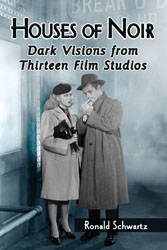For the connoisseur of old wine, it is not impossible to determine origin, year and characteristics of a certain brand or region by taking a sample. The same goes for noir films, which due to lighting, editing, setting, or simply by their respective casts can be traced back to a particular studio or production year by the film expert.
Ronald Schwartz, a Professor Emeritus of film studies, is the author of this small book on thirteen American and British film studios and their output of film noir.
 His approach differs from the „best of“ books concerned with the genre insofar, that here he makes a (very personal) choice and presents only the studio’s best noir, while he elaborates on the individual studio’s policies, its distribution system, financial successes and executives.
His approach differs from the „best of“ books concerned with the genre insofar, that here he makes a (very personal) choice and presents only the studio’s best noir, while he elaborates on the individual studio’s policies, its distribution system, financial successes and executives.
Each of the thirteen movies is analyzed in detail, mentioning also the further careers of actors, composers, art directors, camera crew and directors. Two film stills complete each movie examination to highlight certain unique characteristics of the studio’s approach to the presentation. Additionally, Schwartz shortly recommends the company’s second best movie.
The reader here benefits from the author’s impressive knowledge of classics such as Gilda, Hollow Triumph, Laura, House by the River, The Killers, I Wouldn’t be in Your Shoes, Too Late For Tears and others. Amidst big companies such as Columbia Pictures, Universal Pictures and Warner Bros., lesser-known studios like Monogram (later known as Allied Artists), Eagle-Lion and Republic Pictures are introduced as well.
Interestingly, some of the very best film noir came from the small studios, which, because of their limited budgets, often were referred to as “Poverty Row” of Hollywood.
All in all, Houses of Noir is a nice and entertaining addition to the bookshelf, but maybe mostly intended for the novice film noir fan.
Review by Dr. A. Ebert © 2015
Ronald Schwartz. Houses of Noir: Dark Visions from Thirteen Film Studios. McFarland, 2014, 208 pages.
